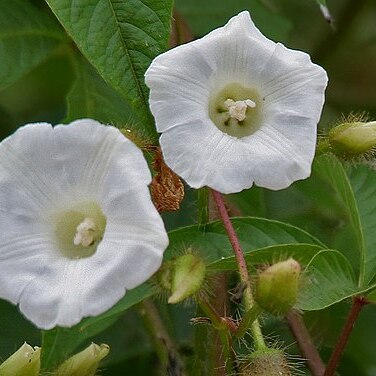Stems twining, slender, terete, hirsute with yellow-brown patent hairs. Leaves palmately compound, with 5 leaflets; leaflets appressed-pilose on both surfaces, sessile, elliptic or elliptic-oblong, 2½-10 by 1-4 cm, acute at the base, acute or acuminate at the apex, entire; petiole slender, as long as or longer than the blade, 2½-12 cm long, patently hirsute. Peduncles axillary, few-to several-flowered, 5-24 cm long, patently hirsute like the 10-25 mm long pedicels. Bracts lanceolate, 2-4 mm long, caducous. Three outer sepals 15-25 mm long, ovate-lanceolate, acute or acuminate, densely hirsute; two inner ones slightly shorter, ovate, acute, glabrous. Corolla funnel-shaped, 2½-3½ cm long, glabrous, white. Anthers spirally twisted. Ovary glabrous, 4-celled. Capsule globose, glabrous, 4-celled, 4-valved. Seeds 4, glabrous.
More
Vines; stems herbaceous, mostly hirsute with long erect to suberect yellowish trichomes. Leaves palmately compound, the 5 leaflets elliptic, entire to dentate, acuminate to acute apically and basally, sparsely pubescent to glabrate. Flowers cymose on long peduncles; sepals oblong, 2 cm long, acute, hirsute with erect yellowish trichomes; corollas white with a purple center, 2-3 cm long. Fruits capsular, subglobose, 1-2 cm in diameter, subtended and partially surrounded by the calyx; seeds black, glabrous.
A scrambling herb. It can be a climber. It keeps growing from year to year. The leaves have five leaflets. These are 3-9 cm long by 2-5 cm wide. The flowers are white. The mature fruit is very hairy. It is a capsule with 4 sections and is 11 mm across.
Riverine vegetation, grassland, open deciduous woodland, Combretum-Terminalia woodland, open forest and as a weed in cultivated land; at elevations up to 1,500 metres.
More
It is a tropical plant. It grows in disturbed areas and water drains. In Argentina it grows from sea level to 1,000 m above sea level.

